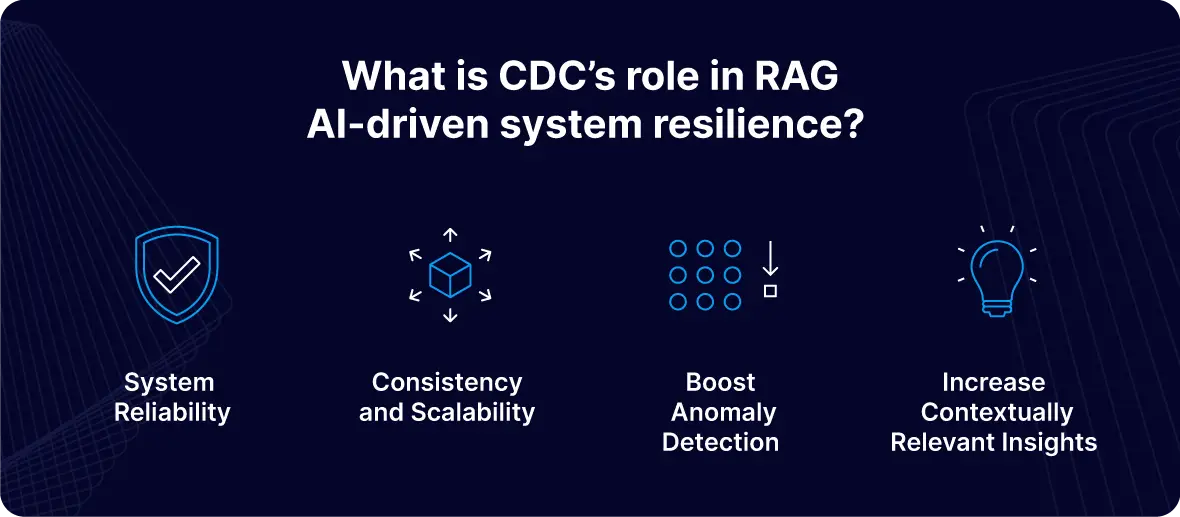Ensuring system resilience is critical for maintaining a competitive edge in today’s data-driven world. As businesses rely on real-time data to fuel decision-making, it’s essential that their systems can withstand disruptions and maintain functionality. Change Data Capture (CDC) is a key player, particularly in AI-driven systems where real-time data integration and adaptive responses are crucial.
In this post, we’ll explore how CDC boosts system resilience in AI-driven environments by enabling Retrieval-Augmented Generation (RAG) models. We’ll focus on how CDC enhances real-time data integration, anomaly detection, and adaptive response mechanisms, making it a cornerstone of RAG AI-driven resilience strategies.
Change Data Capture: Context
CDC is a technology that monitors and records alterations to a system’s database in real-time. Continuous data updates are beneficial for several reasons. First, updates can occur without disrupting the system’s operations. This continuous monitoring allows updates to be detected and processed instantly, minimizing the time lag between when a change occurs and when it is available for analysis. (Want to learn more about why minimizing latency is crucial? Check out this blog.) As a result, data is consistently up-to-date, enabling timely decision-making and immediate insight generation.
In the context of AI systems, real-time data processing is essential for maintaining a steady flow of accurate, relevant data needed for training and updating models. This constant data stream enables AI models to quickly adapt to new information, enhancing their accuracy and effectiveness. As a result, your team Wegains access to more precise predictions, rapid anomaly detection, and adaptive responses.
Where Does RAG Come Into Play?
RAG is an advanced AI framework that combines retrieval-based and generation-based approaches to enhance response accuracy and relevance. Here’s how it works.
- It uses real-time data processing to boost AI capabilities by retrieving the most relevant information from external databases or documents and then generating contextually appropriate responses based on this information.
- The hybrid approach leverages the strengths of both retrieval and generation, ensuring that the AI system provides precise and informed answers.
- By integrating real-time data captured through CDC, RAG systems can generate more accurate and contextually relevant responses.
- This integration ensures that AI outputs are both current and precise, enhancing the overall value and reliability of the system.
CDC’s Role in RAG AI-Driven System Resilience
CDC also plays a pivotal role in enhancing the resilience of RAG AI-driven systems. Since CDC ensures the most current data is available for retrieval and use in generating responses, RAG systems can access and utilize the data without delay. This is crucial to ensure AI-generated content is relevant and accurate.
System Reliability
CDC also contributes to system resilience by reducing downtime and enabling rapid recovery from disruptions. With continuous data synchronization, any changes are promptly replicated across systems, preventing data loss. This ensures that the RAG system remains operational even during system failures or maintenance periods. The seamless integration of data means that the AI system can rapidly bounce back from interruptions, maintaining high levels of service availability and reliability.
Consistency and Scalability
CDC supports the consistency and scalability of RAG systems. By providing a reliable mechanism for data updates, CDC ensures that all components of the AI system can access consistent data. This uniformity is critical for generating coherent, accurate responses, as inconsistencies in data can lead to errors and decreased system performance. As RAG systems scale and incorporate more data sources, CDC facilitates the efficient management of data changes, maintaining the resilience and robustness of the AI-driven system. Through these capabilities, CDC not only enhances the immediate performance of RAG systems but also strengthens their long-term reliability and scalability.
Boost Anomaly Detection
Moreover, real-time data integration supports proactive anomaly detection. When AI systems are fed with the most current data, they can more effectively identify deviations from the norm and alert stakeholders to potential issues before they escalate. This proactive approach not only enhances operational efficiency but also mitigates risks, further contributing to the resilience of the system.
Increase Contextually Relevant Insights
RAG enhances this process by leveraging real-time data to provide more accurate and contextually relevant insights. By integrating real-time data captured through CDC, RAG models can retrieve the latest information and generate informed responses. This capability ensures that any detected anomalies are addressed with the most up-to-date data, allowing for swift and precise corrective actions. In this way, RAG plays a crucial role in enhancing the system’s resilience by ensuring that responses to potential issues are both timely and well-informed.
Adaptive Response Mechanisms: Ensuring Continuity and Reliability
Adaptive response mechanisms are essential for maintaining continuity and reliability in AI-driven systems. CDC empowers these mechanisms by providing a steady stream of up-to-date data that RAG models can use to adjust their outputs in real-time. This dynamic adaptability is particularly valuable in scenarios where conditions can change rapidly, such as in cybersecurity, healthcare, and supply chain management.
For example, in cybersecurity, adaptive response mechanisms can leverage real-time data to identify and respond to threats as they emerge, preventing breaches and minimizing damage. Similarly, in healthcare, real-time patient data can enable AI-driven systems to adjust treatment plans on the fly, improving patient outcomes. CDC ensures that these adaptive responses are based on the latest and most accurate data, enhancing the system’s ability to maintain functionality and resilience under varying conditions.
Strengthening AI System Resilience with CDC and RAG
In today’s competitive landscape, the resilience of AI-driven systems is paramount. CDC is a critical component in building this resilience, particularly in the context of RAG models.
Book a demo today to learn more about how Striim utilizes CDC to ensure your organization has constant access to real-time data.























